Abstract
Net fluid transport was measured in denervated jejunal segments of rats infected with larvae of Nippostrongylus brasiliensis. On days 6-9 after nematode inoculation, when the jejunal segment exhibited macroscopic and microscopic signs of inflammation, net fluid absorption was noticeably attenuated compared with control, and in eight of 26 experiments a net fluid secretion was seen. To determine whether enteric nerves participated in the response, intravenous hexamethonium (10 mg/kg body weight) was given or lidocaine (1% solution) was placed on the serosa of the intestinal segment. Both drugs significantly reduced fluid secretion or increased fluid absorption. The effect was more pronounced the lower the rate of fluid absorption or the higher the rate of fluid secretion. The inflammatory response influenced intestinal fluid transport partly via activation of the enteric nervous system. It was estimated that 50-60% of the change in fluid transport caused by the parasite could be ascribed to activation of intramural nervous reflexes. The effect of hexamethonium indicates that a cholinergic synapse is present in the secretory nervous reflux activated by inflammation. Experiments were also performed on animals on days 11-14 after infection when the nematodes had been expelled from the animal. A large net fluid absorption was then recorded.
Full text
PDF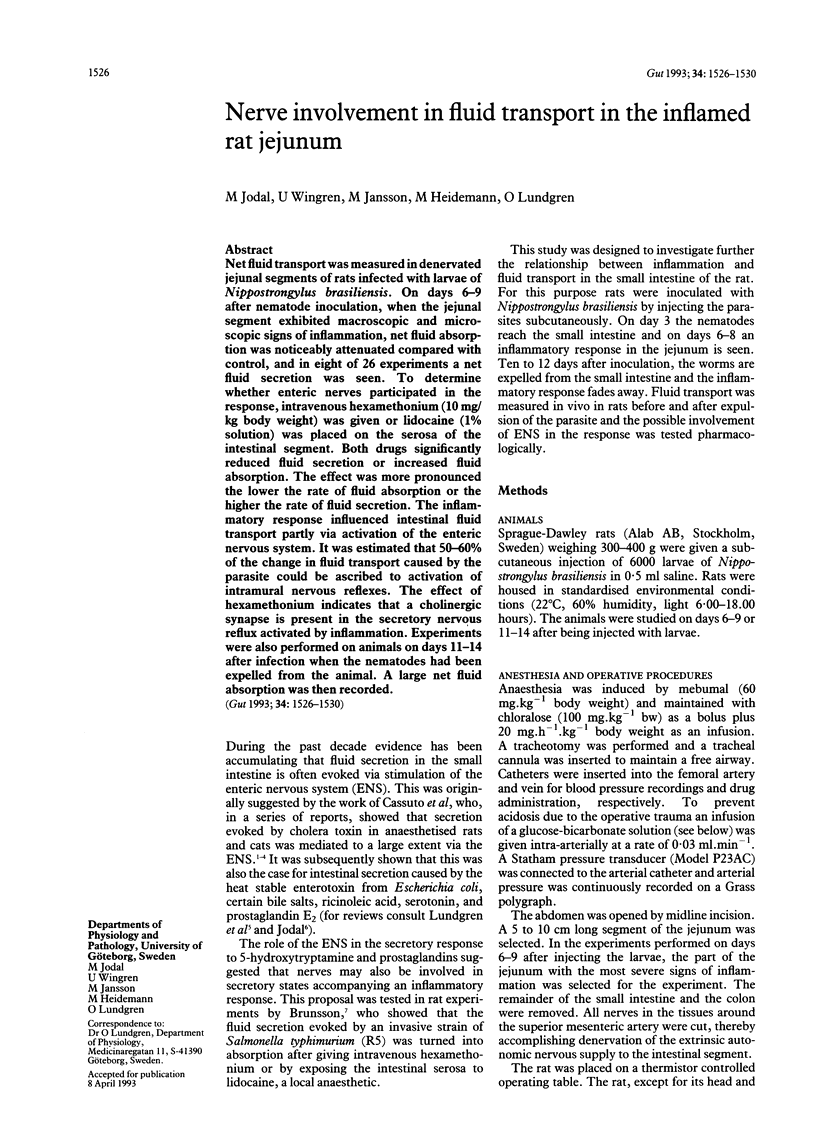
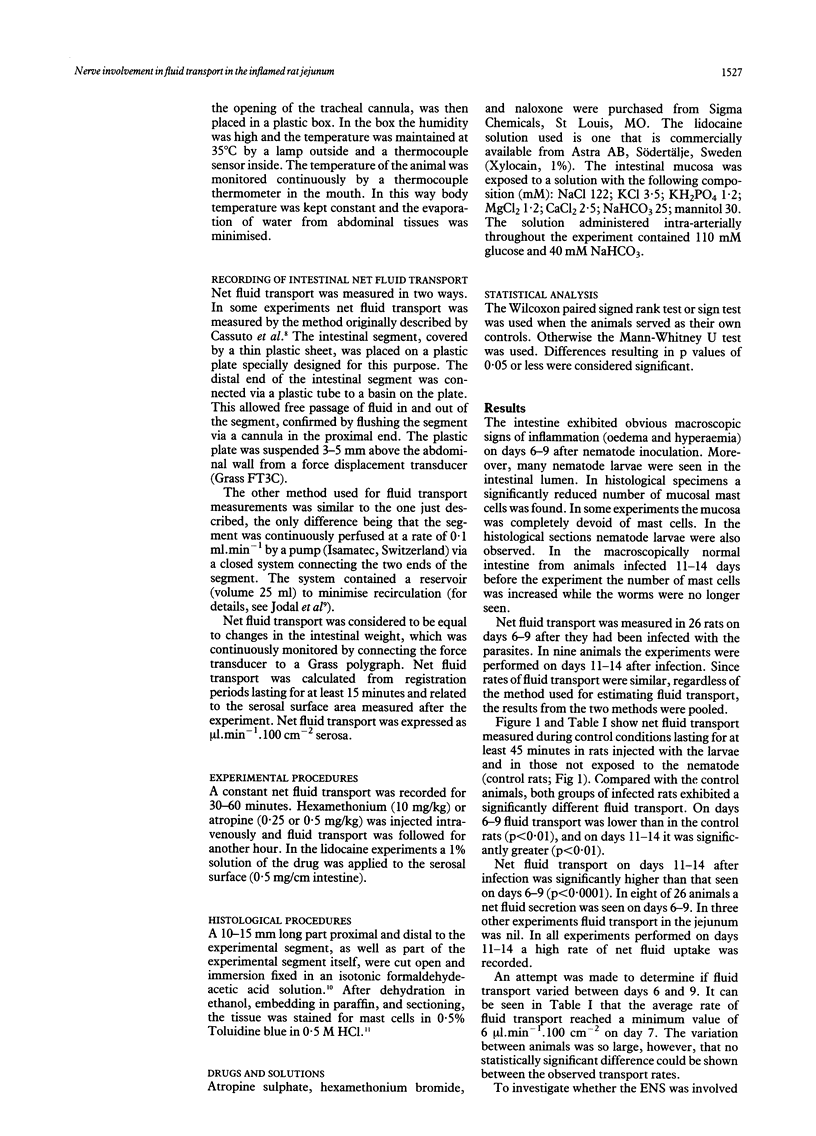
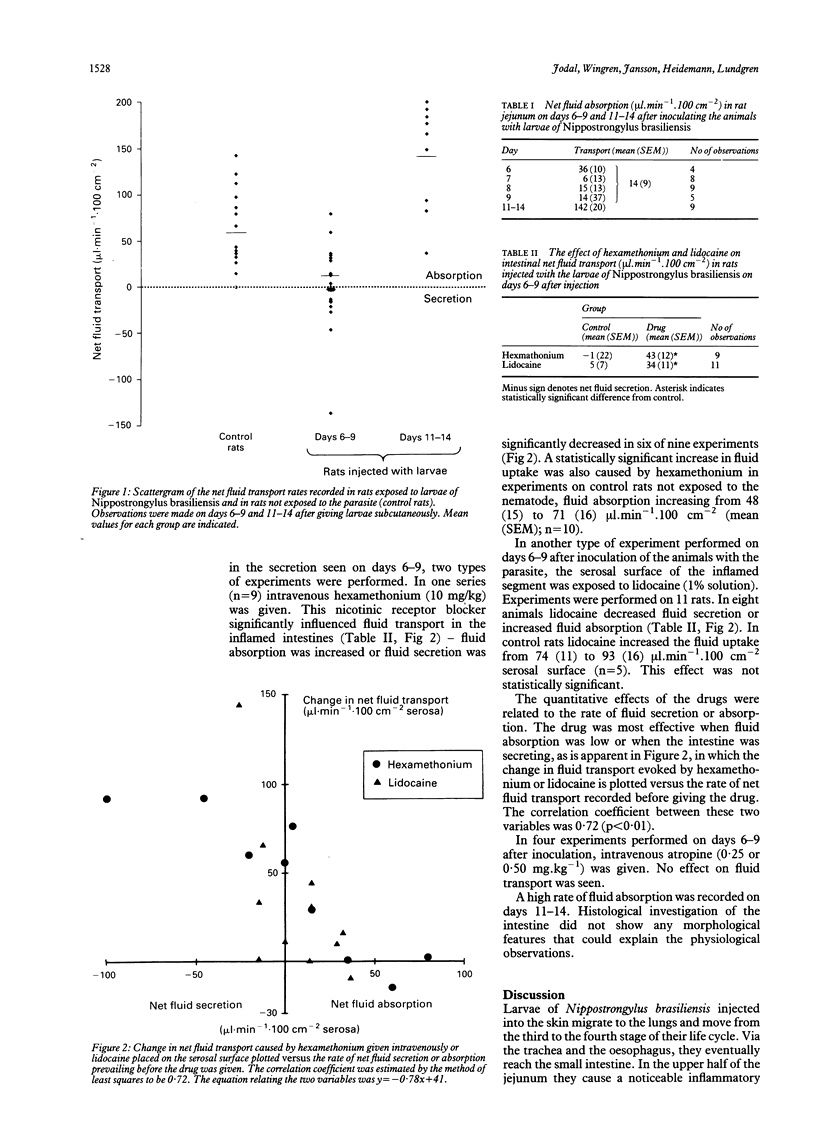
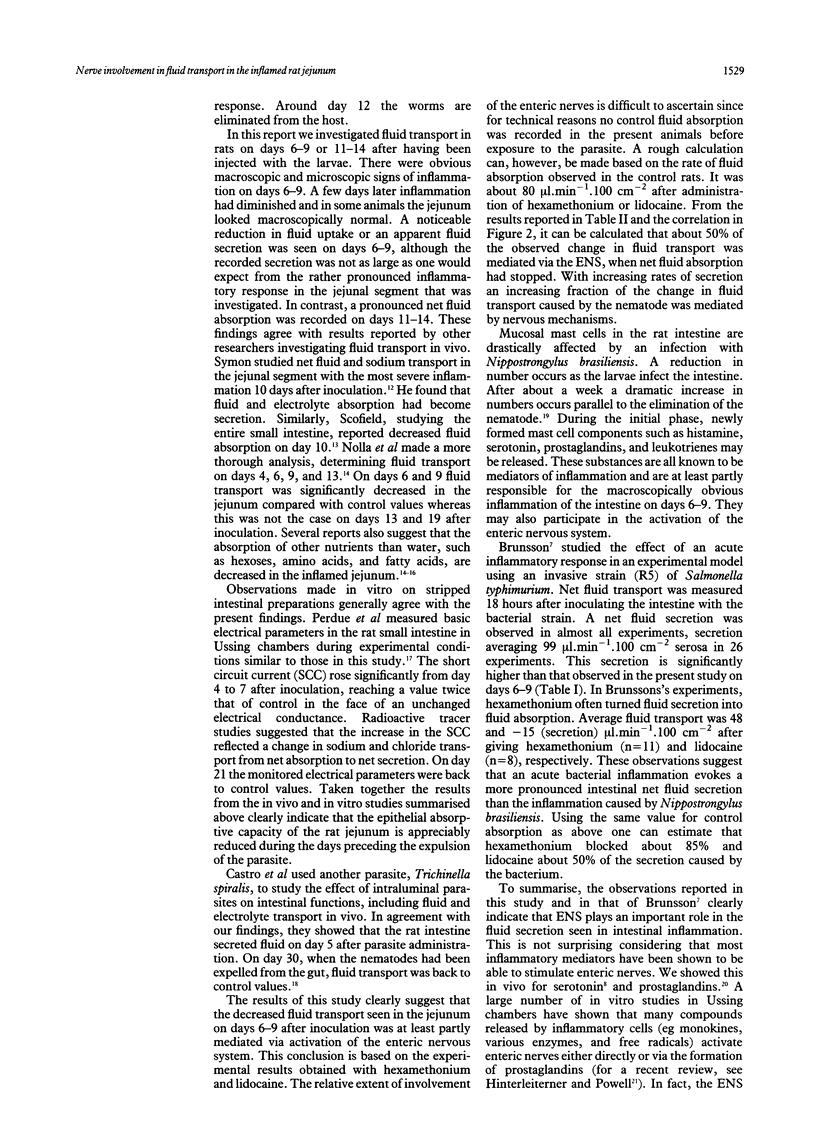
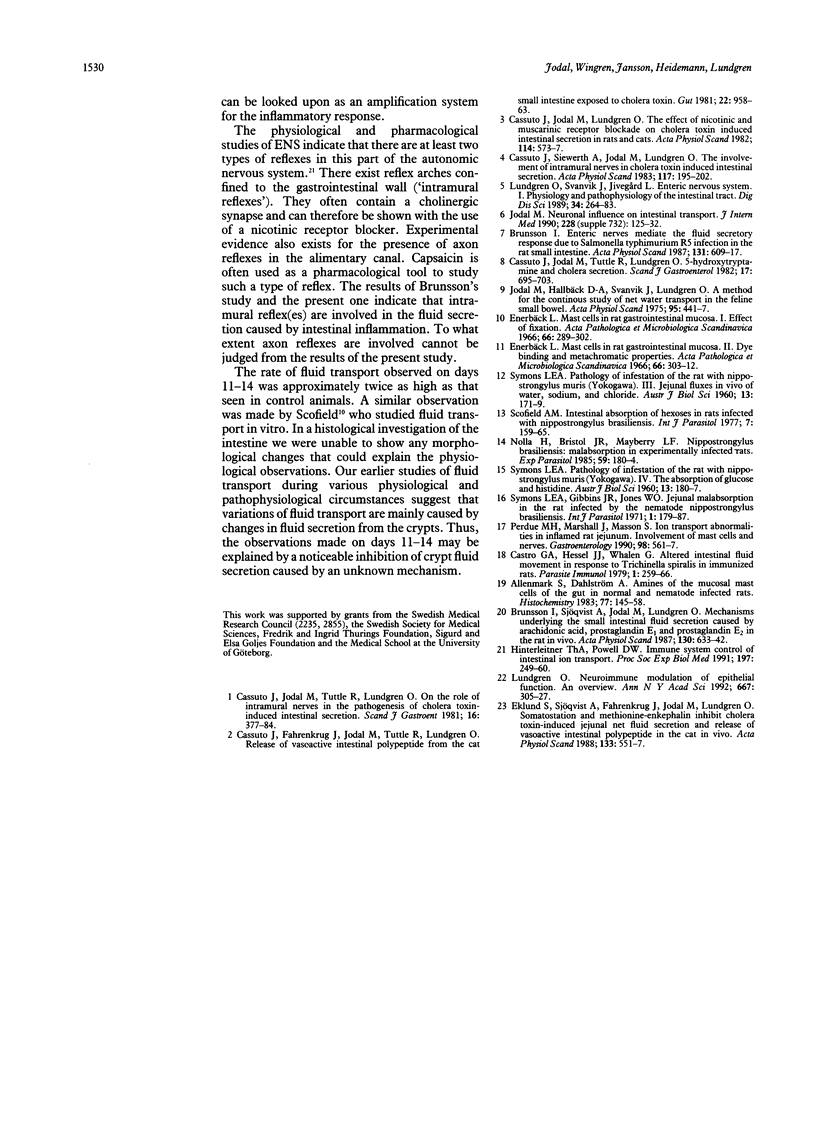
Selected References
These references are in PubMed. This may not be the complete list of references from this article.
- Brunsson I. Enteric nerves mediate the fluid secretory response due to Salmonella typhimurium R5 infection in the rat small intestine. Acta Physiol Scand. 1987 Dec;131(4):609–617. doi: 10.1111/j.1748-1716.1987.tb08282.x. [DOI] [PubMed] [Google Scholar]
- Brunsson I., Sjöqvist A., Jodal M., Lundgren O. Mechanisms underlying the small intestinal fluid secretion caused by arachidonic acid, prostaglandin E1 and prostaglandin E2 in the rat in vivo. Acta Physiol Scand. 1987 Aug;130(4):633–642. doi: 10.1111/j.1748-1716.1987.tb08186.x. [DOI] [PubMed] [Google Scholar]
- Cassuto J., Fahrenkrug J., Jodal M., Tuttle R., Lundgren O. Release of vasoactive intestinal polypeptide from the cat small intestine exposed to cholera toxin. Gut. 1981 Nov;22(11):958–963. doi: 10.1136/gut.22.11.958. [DOI] [PMC free article] [PubMed] [Google Scholar]
- Cassuto J., Jodal M., Lundgren O. The effect of nicotinic and muscarinic receptor blockade on cholera toxin induced intestinal secretion in rats and cats. Acta Physiol Scand. 1982 Apr;114(4):573–577. doi: 10.1111/j.1748-1716.1982.tb07026.x. [DOI] [PubMed] [Google Scholar]
- Cassuto J., Jodal M., Tuttle R., Lundgren O. 5-hydroxytryptamine and cholera secretion. Physiological and pharmacological studies in cats and rats. Scand J Gastroenterol. 1982 Aug;17(5):695–703. doi: 10.3109/00365528209181081. [DOI] [PubMed] [Google Scholar]
- Cassuto J., Jodal M., Tuttle R., Lundgren O. On the role of intramural nerves in the pathogenesis of cholera toxin-induced intestinal secretion. Scand J Gastroenterol. 1981 Apr;16(3):377–384. doi: 10.3109/00365528109181984. [DOI] [PubMed] [Google Scholar]
- Cassuto J., Siewert A., Jodal M., Lundgren O. The involvement of intramural nerves in cholera toxin induced intestinal secretion. Acta Physiol Scand. 1983 Feb;117(2):195–202. doi: 10.1111/j.1748-1716.1983.tb07197.x. [DOI] [PubMed] [Google Scholar]
- Castro G. A., Hessel J. J., Whalen G. Altered intestinal fluid movement in response to Trichinella spiralis in immunized rats. Parasite Immunol. 1979 Winter;1(4):259–266. doi: 10.1111/j.1365-3024.1979.tb00711.x. [DOI] [PubMed] [Google Scholar]
- Eklund S., Sjöqvist A., Fahrenkrug J., Jodal M., Lundgren O. Somatostatin and methionine-enkephalin inhibit cholera toxin-induced jejunal net fluid secretion and release of vasoactive intestinal polypeptide in the cat in vivo. Acta Physiol Scand. 1988 Aug;133(4):551–557. doi: 10.1111/j.1748-1716.1988.tb08440.x. [DOI] [PubMed] [Google Scholar]
- Enerbäck L. Mast cells in rat gastrointestinal mucosa. 2. Dye-binding and metachromatic properties. Acta Pathol Microbiol Scand. 1966;66(3):303–312. doi: 10.1111/apm.1966.66.3.303. [DOI] [PubMed] [Google Scholar]
- Enerbäck L. Mast cells in rat gastrointestinal mucosa. I. Effects of fixation. Acta Pathol Microbiol Scand. 1966;66(3):289–302. doi: 10.1111/apm.1966.66.3.289. [DOI] [PubMed] [Google Scholar]
- Hinterleitner T. A., Powell D. W. Immune system control of intestinal ion transport. Proc Soc Exp Biol Med. 1991 Jul;197(3):249–260. doi: 10.3181/00379727-197-43252. [DOI] [PubMed] [Google Scholar]
- Jodal M., Hallbäck D. A., Svanvik J., Lundgren O. A method for the continuous study of net water transport in the feline small bowel. Acta Physiol Scand. 1975 Dec;95(4):441–447. doi: 10.1111/j.1748-1716.1975.tb10072.x. [DOI] [PubMed] [Google Scholar]
- Jodal M. Neuronal influence on intestinal transport. J Intern Med Suppl. 1990;732:125–132. doi: 10.1111/j.1365-2796.1990.tb01484.x. [DOI] [PubMed] [Google Scholar]
- Lundgren O., Svanvik J., Jivegård L. Enteric nervous system. I. Physiology and pathophysiology of the intestinal tract. Dig Dis Sci. 1989 Feb;34(2):264–283. doi: 10.1007/BF01536062. [DOI] [PubMed] [Google Scholar]
- Nolla H., Bristol J. R., Mayberry L. F. Nippostrongylus brasiliensis: malabsorption in experimentally infected rats. Exp Parasitol. 1985 Apr;59(2):180–184. doi: 10.1016/0014-4894(85)90070-0. [DOI] [PubMed] [Google Scholar]
- Owen J. Possibilities and limitations of reaction product analysis. Ann N Y Acad Sci. 1992 Dec 4;667:305–309. doi: 10.1111/j.1749-6632.1992.tb51631.x. [DOI] [PubMed] [Google Scholar]
- Perdue M. H., Marshall J., Masson S. Ion transport abnormalities in inflamed rat jejunum. Involvement of mast cells and nerves. Gastroenterology. 1990 Mar;98(3):561–567. doi: 10.1016/0016-5085(90)90274-5. [DOI] [PubMed] [Google Scholar]
- Scofield A. M. Intestinal absorption of hexoses in rats infected with Nippostrongylus brasiliensis. Int J Parasitol. 1977 Apr;7(2):159–165. doi: 10.1016/0020-7519(77)90085-6. [DOI] [PubMed] [Google Scholar]
- Symons L. E., Gibbins J. R., Jones W. O. Jejunal malabsorption in the rat infected by the nematode Nippostrongylus brasiliensis. Int J Parasitol. 1971 Sep;1(2):179–187. doi: 10.1016/0020-7519(71)90013-0. [DOI] [PubMed] [Google Scholar]
- Wingren U., Enerbäck L., Ahlman H., Allenmark S., Dahlström A. Amines of the mucosal mast cell of the gut in normal and nematode infected rats. Histochemistry. 1983;77(2):145–158. doi: 10.1007/BF00506557. [DOI] [PubMed] [Google Scholar]


